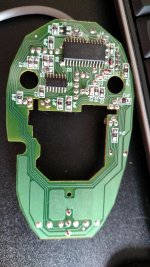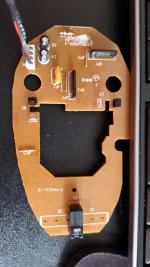-
Updated 2023-07-12: Hello, Guest! Welcome back, and be sure to check out this follow-up post about our outage a week or so ago.
You are using an out of date browser. It may not display this or other websites correctly.
You should upgrade or use an alternative browser.
You should upgrade or use an alternative browser.
Kensington Mouse-in-a-Box (ADB) on Mac OS 7.6.1?
- Thread starter Floofies
- Start date
shadedream
Well-known member
What's not working? I cant see why it wouldn't work. If it's not working entirely I'd try to confirm it's actually working at all on another machine if you can.
Floofies
Maker of Logos
I have it plugged into an Apple Design Keyboard's ADB port and it doesn't seem to be detecting the mouse at all (clicks and movement). I have a stock Apple Desktop Bus Mouse 2 that works fine on the same port.What's not working? I cant see why it wouldn't work. If it's not working entirely I'd try to confirm it's actually working at all on another machine if you can.
I was thinking I'd need drivers for it, but you think the mouse might be dead?
Floofies
Maker of Logos
Hmm yeah, my stock mouse works fine...I've have had a couple of Kensington Trackballs for Mac (ADB) and a joystick and they worked from System 6 to 7.6.1 without a driver.
Check if a mouse works on those ports, and if yes, then something in the Mouse-in-a-Box is broken.
I popped it open and can't find anything wrong :-/ Maybe it's the cable? I'll do a continuity check on it.
Also, I'll plug it in while the casing is open. Do you know if the optical components visibly light up, or is it an invisible wavelength?
Here's some photos:


Last edited by a moderator:
Elfen
Well-known member
Replace the two caps you got up there by the wire harness. Though they look clean, any electrolytic caps older than 10 years should be suspect for replacement because they would leak over time.
Also, to me, it looks it took a soda bath long ago. Just before removing the caps:
- Dunk in warm water to loosen up and remove the old sugar.
- Then dunk and rinse out in acetone to remove any cap goo.
- Lastly rinse out in high proof alcohol (I use 70% or higher Isopropyl when I can find it.) and then let dry.
Without powering up the unit, it is hard to tell if the LEDs are Red or IR. A continuity check of the cable would be best.
Also, to me, it looks it took a soda bath long ago. Just before removing the caps:
- Dunk in warm water to loosen up and remove the old sugar.
- Then dunk and rinse out in acetone to remove any cap goo.
- Lastly rinse out in high proof alcohol (I use 70% or higher Isopropyl when I can find it.) and then let dry.
Without powering up the unit, it is hard to tell if the LEDs are Red or IR. A continuity check of the cable would be best.
Floofies
Maker of Logos
Ahhh! So that's what that weird shiny buildup is! I assumed it was glue or something! I'll definitely give it a good bath now. I have 70% Isopropyl as well.Replace the two caps you got up there by the wire harness. Though they look clean, any electrolytic caps older than 10 years should be suspect for replacement because they would leak over time.
Also, to me, it looks it took a soda bath long ago. Just before removing the caps:
- Dunk in warm water to loosen up and remove the old sugar.
- Then dunk and rinse out in acetone to remove any cap goo.
- Lastly rinse out in high proof alcohol (I use 70% or higher Isopropyl when I can find it.) and then let dry.
Without powering up the unit, it is hard to tell if the LEDs are Red or IR. A continuity check of the cable would be best.
I did a check on the cable, and only 2 of the pins go all the way to the PCB: pins 1 and 3.
As far as I can tell, pins 4 and 2 don't matter for mice as they're for ground and the "power on" signal.
I also found that the metal plug (the mini-DIN casing) also registers on pin 1 with my voltmeter. Since pin 1 is for data... wouldn't that make it ground out?
Floofies
Maker of Logos
Okay so, I left it in warm water for about 5 minutes, and rinsed it with alcohol. I don't have any acetone, but I didn't see any leakage whatsoever around the caps before the wash.Replace the two caps you got up there by the wire harness. Though they look clean, any electrolytic caps older than 10 years should be suspect for replacement because they would leak over time.
Also, to me, it looks it took a soda bath long ago. Just before removing the caps:
- Dunk in warm water to loosen up and remove the old sugar.
- Then dunk and rinse out in acetone to remove any cap goo.
- Lastly rinse out in high proof alcohol (I use 70% or higher Isopropyl when I can find it.) and then let dry.
Without powering up the unit, it is hard to tell if the LEDs are Red or IR. A continuity check of the cable would be best.
No effect, I think... I decided to bust out the voltmeter again and test it while plugged in and powered. Between Pin 1 + pins 3, and whatever the Red cable is, there's about 0.033 Volts DC going between them. I also tested the caps, and 0.044 Volts DC are going through those. I'm leaning towards the cable being bad...That or, something broken on the PCB is messing up the ADB controller in my Quadra 630.
Last edited by a moderator:
techknight
Well-known member
double post...
Last edited by a moderator:
techknight
Well-known member
umm.. no, no, and umm no....Ahhh! So that's what that weird shiny buildup is! I assumed it was glue or something! I'll definitely give it a good bath now. I have 70% Isopropyl as well.
I did a check on the cable, and only 2 of the pins go all the way to the PCB: pins 1 and 3.
As far as I can tell, pins 4 and 2 don't matter for mice as they're for ground and the "power on" signal.
I also found that the metal plug (the mini-DIN casing) also registers on pin 1 with my voltmeter. Since pin 1 is for data... wouldn't that make it ground out?
You have a break or short in the cable.
And the shield is ground. if you have pin 1 connected to shield, then pin 1 is ground. You should have power, ground, ADB Data, and Open Circuit.
Last edited by a moderator:
techknight
Well-known member
Floofies
Maker of Logos
I'll strip the outer insulation and see what the deal is. Also, I thought Pin 1 is supposed to be data, not ground?umm.. no, no, and umm no....
You have a break or short in the cable.
And the shield is ground. if you have pin 1 connected to shield, then pin 1 is ground. You should have power, ground, ADB Data, and Open Circuit.
Must be the break in the cable mucking up my tests, but I tested from each pin in the mini-DIN (with this graph for reference) to the pins on the PCB and found the opposite of your notes.Look at the attached photo with my notes.
Mini-DIN Casing = Black
Pin 1, Data = Black
Pin 3, 5v Power = Orange
Last edited by a moderator:
techknight
Well-known member
I figured.
Similar threads
- Replies
- 5
- Views
- 516

